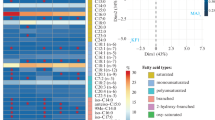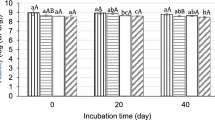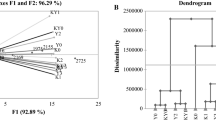Abstract
Volatile compound profiles of probiotic yogurt samples prepared using 8 different prebiotic combinations were analyzed using gas chromatography/mass spectrometry (GC-MS) with solid phase micro extraction during 28 days of storage. A total of 40 volatile compounds were identified in yogurt samples during storage consisting of 2 aldehydes, 6 ketones, 4 alcohols, 6 acids, 5 esters, 3 terpenes, 3 aromatic hydrocarbons, and 12 aliphatic hydro-carbons. Acetaldehyde, diacetyl, acetoin, 2-heptanone, ethanol, isoamyl alcohol, acetic acid, caproic acid, caprilic acid, and capric acid were the major volatile compounds in all probiotic yogurt samples.
Similar content being viewed by others
References
Tamime AY, Robinson RK. Yogurt Science and Technology. 2nd ed. Woodhead Publishing Ltd., Cambridge, UK. p. 619 (1999)
Dave RI, Shah NP. Ingredient supplemention effects on viability of probiotic bacteria in yogurt. J. Dairy Sci. 81: 2804–2816, (1998)
Izzo M, Franck A. Nutritional and health benefits of inulin and oligofructose conference. Trends Food Sci. Tech. 9: 255–257, (1998)
Holzapfel WH, Schillinger U. Introduction to pre- and probiotics. Food Res. Int. 35: 109–116, (2002)
Ha E, Zemel MB. Functional properties of whey, whey components, and essential amino acids: Mechanism underlying health benefits for active people (review). J. Nutr. Biochem. 14: 251–258, (2003)
Kailasapathy K, Supriadi D, Hourigan JA. Effect of partially replacing skim milk powder with whey protein concentrate on buffering capacity of yogurt. Aust. J. Dairy Technol. 51: 89–93, (1996)
Ott A, Fay LB, Chaintreau A. Determination and origin of the aroma impact compounds of yogurt flavor. J. Agr. Food Chem. 45: 850–858, (1997)
Ott A, Hugi A, Baumgartner M, Chaintreau A. Sensory investigation of yogurt flavor perception: Mutual influence of volatiles and acidity. J. Agr. Food. Chem. 48: 441–450, (2000)
Tamime AY, Deeth HC. Yogurt technology and biochemistry. J. Food Protect. 43: 939–977, (1980)
McSweeney PLH, Sousa MJ. Biochemical pathways for the production of flavor compounds in cheeses during ripening. A review. Lait 80: 293–324, (2000)
Kurt A, Çakmakçi S, Çaglar A. The guide of inspection and analysis methods of milk and dairy products. Publications No: 252D, Atatürk University, Erzurum, Turkey. p. 254 (2007)
Marco A, Navarro JL, Flores M. Volatile compounds of dry-fermented sausages as affected by solid-phase microextraction (SPME). Food Chem. 84: 633–641, (2004)
Bakırcı I, Kavaz A. An investigation of some properties of banana yogurts made with commercial ABT-2 starter culture during storage. Int. J. Dairy Technol. 61: 270–276, (2008)
Lees GJ, Jago GR. Role of acetaldehyde in metabolism: A review 2. The metabolism of acetaldehyde in cultured dairy products. J. Dairy Sci. 61: 1216–1224, (1978)
Beshkova D, Simova E, Frengova G, Simov Z. Production of flavor compounds by yogurt starter cultures. J. Ind. Microbiol. Biotechnol. 20: 180–186, (1998)
Gallardo-Escamilla FJ, Kelly AL, Delahunty CM. Influence of starter culture on flavor and headspace volatile profiles of fermented whey and whey produced from fermented milk. J. Dairy Sci. 88: 3745–3753, (2005)
Özer D, Akin S, Özer B. Effect of inulin and lactulose on survival of Lactobacillus acidophilus LA-5 and Bifidobacterium bifidum BB-02 in Acidophilus-Bifidus yogurt. Food Sci. Technol. Int. 11: 19–24, (2005)
Güven M, Yasar K, Karaca OB, Hayaloglu AA. The effect of inulin as a fat replacer on the quality of set-type low-fat yogurt manufacture. Int. J. Dairy Technol. 58: 180–184, (2005)
Borle F, Sieber R, Bosset JO. Photo-oxidation and photo protection of foods, especially of dairy products. Sci. Aliment. 21: 571–590, (2001)
Saint-Eve A, Levy C, Le Moigne M, Ducruet V, Souchon I. Quality changes in yogurt during storage in different packaging materials. Food Chem. 110: 285–293, (2008)
Molimard P, Spinnler HE. Review: Compounds involved in the flavor of surface mold-ripened cheeses: Origins and properties. J. Dairy Sci. 79: 169–184, (1996)
Quintans NG, Blancato V, Repizo G, Magni C, Lopez P. Citrate metabolism and aroma compound production in lactic acid bacteria. In: Molecular Aspects of Lactic Acid Bacteria for Traditional and New Applications. Mayo B, López P, Pérez-Martínez G (eds). Research Signpost, Kerala, India. pp. 65–88 (2008)
Macciola V, Candela G, De Leonardis A. Rapid gaschromatographic method for the determination of diacetyl in milk, fermented milk and butter. Food Control 19: 873–878, (2008)
Serra M, Trujillo AJ, Guamis B, Ferragut V. Flavor profiles and survival of starter cultures of yogurt produced from high-pressure homogenized milk. Int. Dairy J. 19: 100–106, (2009)
Pinto SM, Clemente MDG, Abreu LRD. Behaviour of volatile compounds during the shelf life of yogurt. Int. J. Dairy Technol. 62: 215–223, (2009)
Curioni PMG, Bosset JO. Key odorants in various cheese types as determined by gas chromatography-olfactometry. Int. Dairy J. 12: 959–984, (2002)
Adhikari K, Grün IU, Mustapha A, Fernando LN. Changes in the profile of organic acids in plain set and stirred yogurts during manufacture and refrigerated storage. J. Food Quality 25: 435–451, (2002)
Bendall JG. Aroma compounds of fresh milk from New Zealand cows fed different diets. J. Agr. Food Chem. 49: 4825–4832, (2001)
Rychlik M, Sax M, Schieberle P. On the role of short-chain free fatty acids for the development of a cheese-like off-note in pasteurized yogurt. LWT-Food Sci. Technol. 39: 521–527, (2006)
Sieber R, Bütikofer U, Bosset JO. Benzoic acid as a natural compound in cultured dairy products and cheese. Int. Dairy J. 5: 227–246, (1995)
Author information
Authors and Affiliations
Corresponding author
Rights and permissions
About this article
Cite this article
Yüksel, A.K., Bakırcı, İ. An investigation of the volatile compound profiles of probiotic yogurts produced using different inulin and demineralised whey powder combinations. Food Sci Biotechnol 24, 807–816 (2015). https://doi.org/10.1007/s10068-015-0105-0
Received:
Revised:
Accepted:
Published:
Issue Date:
DOI: https://doi.org/10.1007/s10068-015-0105-0




